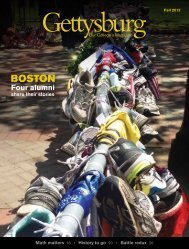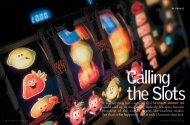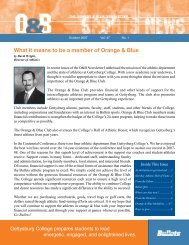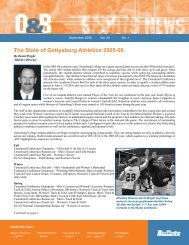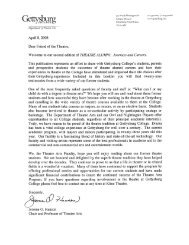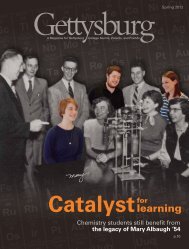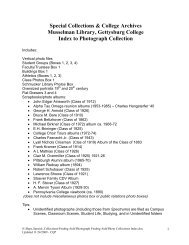Fall 2012 - Gettysburg College
Fall 2012 - Gettysburg College
Fall 2012 - Gettysburg College
You also want an ePaper? Increase the reach of your titles
YUMPU automatically turns print PDFs into web optimized ePapers that Google loves.
spEciaL coLLEctions Exhibit:<br />
Slaves, Soldiers, Citizens<br />
Starting this April, Special Collections will be exhibiting<br />
“Slaves, Soldiers, Citizens: African American Artifacts of the<br />
Civil War Era.” The exhibit gives a chilling glimpse into the<br />
lives of slaves including items of the “trade” such as bills of<br />
sale, shackles (shown below), posters seeking runaways, as<br />
well as everyday items handmade by slaves, like a clay bowl.<br />
It also shows images and documentation of African American<br />
Civil War soldiers and the beginnings of racial integration after<br />
the War. A smaller preview exhibit is on display now.<br />
This collection is on loan from Angelo Scarlato of Etters, PA,<br />
who has been collecting Civil War and slave-related artifacts<br />
for years. One of the pieces in the collection is a photograph<br />
(ca. 1900) that was featured on the PBS show “History<br />
Detectives” in 2007 (shown above). Scarlato purchased it<br />
13<br />
because it showed a group<br />
of uniformed Civil War<br />
veterans, which included<br />
two men of African<br />
descent. “Given the<br />
social climate at the<br />
time, I find this to be<br />
rather unusual,” he<br />
told the show’s host<br />
Elyse Luray.<br />
This photo of members<br />
of the Grand Army of the<br />
Republic (GAR), the first<br />
major veterans’ organization<br />
A potholder made by a slave from<br />
a Confederate soldier’s uniform.<br />
in America, was taken in Cazenovia, NY. “GAR posts like<br />
Cazenovia’s were the first racially integrated organizations in<br />
American history,” according to Luray. That clue helped PBS’s<br />
“History Detectives” determine the identities of the two African<br />
American soldiers—John Stevenson and Alberto Robbins.<br />
The show also found a descendant of Stevenson’s in New<br />
Mexico, and brought him to Cazenovia to meet Scarlato and<br />
visit his great-great-grandfather’s grave. The episode will be<br />
playing periodically in Special Collections.<br />
This exhibit is curated by Lauren Roedner ’13, a double major<br />
in history and African American studies with a minor in Civil<br />
War Era studies.



